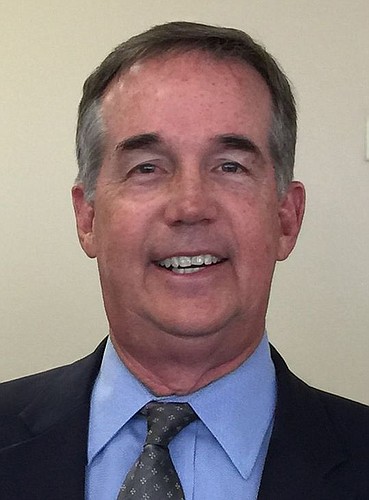
Outgoing state Chief Financial Officer Jeff Atwater considers Jacksonville’s consolidated government an asset when it comes to securing funding for infrastructure and other elements.
“You have continued to be strong here,” Atwater said.
Strength and resolve headlined Atwater’s themes Monday when he spoke to almost 90 members and guests of the Economic Roundtable of Jacksonville lunch meeting at Jacksonville University.
The roundtable’s focus is to promote the discussion of economic topics relevant to Northeast Florida through a speaker series. The Daily Record is a corporate sponsor and I serve on its board.
Atwater’s appearance was particularly timely. He announced Friday he will leave the Cabinet post at the end of the legislative session to take a leadership role at Florida Atlantic University.
“I have about 120 days to go,” said the 58-year-old former banker who spent 10 years in Jacksonville during his career with Barnett Bank.
Atwater focused Monday on a presentation titled “Fiscal discipline attracts capital.”
“Once you deploy a resource,” he said, “you can’t get it back.”
That was the state’s orientation toward taxpayer dollars, especially as it navigated the Great Recession of 2007-09 and its aftermath.
Atwater outlined Florida’s economy before and after the recession and how the conservative approach on lowering taxes, building reserves and reducing spending kept the state stronger than others.
He also compared the state’s approaches to fiscal challenges with those of other states, showing “the consequences of decision-making.”
As CFO, Atwater runs the Florida Department of Financial Services, including its 15 divisions like Consumer Services. He also is state fire marshal.
His office website says he runs the state’s accounting and auditing functions and unclaimed property, oversees the investment of state funds and manages the Florida’s deferred compensation and risk management programs.
Copies of Atwater’s “Florida’s Bottom Line” at the event provided a 2017 optimistic economic outlook for the state and the year in review.
It coincides with a more recent state report. On Thursday, the Florida Legislature Office of Economic and Demographic Research released its periodic “Florida: An Economic Overview” report that concluded the economy hasn’t completely recovered since the national downturn of 2007-09.
“It will take another year to climb completely out of the hole left by the recession,” it said.
Florida’s growth rates generally are returning to more typical levels, it said, and the “drags,” especially construction, are more persistent than in past downturns.
However, the strength in tourism is largely compensating for that, it said.
By the end of the 2015-16 fiscal year, most measures of the Florida economy had returned to or surpassed previous peaks. None of the key construction metrics are expected to show a return to peak levels until 2020-21, it said.
State general revenue collections surpassed the 2005-06 peak in fiscal 2014-15. After slowing the past fiscal year, growth is expected to pick up this year and through 2019-20 as construction recovers.
Population growth is the state’s primary engine of economic growth, fueling both employment and economic growth, it said.
That annual growth is expected to average 1.6 percent annually between 2015 and 2020.
Most of Florida’s population growth through 2030 will be from people moving in. The report said net migration will account for 93.1 percent of the growth.
Florida is the third largest state by population in the country, taking that spot in 2014 when it neared the 20 million mark, surpassing New York.
It is forecasted to reach 24.2 million by 2030 and 26.4 million by 2040.
The office predicts long-run annual growth of 3.5 percent.
The report also shows as the state economy continues to grow, it has been losing a little steam.
The state’s Gross Domestic Product growth of 4 percent in 2015 slowed to a 3.6 percent annual rate in the third quarter of 2016, ranking it 29th in the country.
Personal income growth also “showed a slight weakening from the second quarter to the third,” according to the report.
The state’s December unemployment rate of 4.9 percent was higher than the national rate of 4.7 percent and higher than 30 states.
Yet, the Florida rate was less than half of its high of 11.2 percent from November 2009 to January 2010. The lowest monthly rate was 3.1 percent in March-April 2006.
And while the state’s job market is recovering, more jobs are needed to address the population increase since 2007, according to the report.
Another 421,000 jobs are needed for the same percentage of the population over 16 to be employed as at the peak.
Building permits continue to increase, but no county has surpassed its peak activity. Still, existing home sales volume in 2014 and 2015 exceeded the 2005 peak year, the report said.
Florida had the fourth highest foreclosure rate in 2016, but foreclosure inventory fell and is expected to “normalize” by the end of 2018.
In Atwater’s report, University of Central Florida economist Sean Snaith wrote he has revised his outlook for the state upward in the wake of the election of President Donald Trump.
Snaith expects real state GDP will expand at a 3.8 percent rate this year and job growth will approach 3 percent, both outpacing the U.S.
However, he warned that while the domestic environment will become more conducive to economic growth, “a stronger dollar and a global economy that is peppered with potential pitfalls are significant risks to on the economic horizon.”
All told, he wrote, “I am quite optimistic about the economic outlook for Florida’s economy. 2017 should be a good year.”
@MathisKb
(904) 356-2466